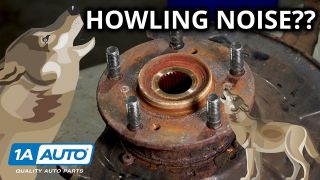
Top 5 Problems Honda Element SUV 1st Generation 2003-11
Created on: 2021-03-20
Sue points out the most common problems with the Element, and offers tips and suggestions to get you started on fixing any of these problems you might encounter with your own Element!
In this video, we're gonna talk about the top five problems we found with the '03 Element. And that's '03 to '11, only 1 Gen. Number one, major oil leak. Now, if you look on the internet out there in the YouTube world, you're gonna see a million of these being changed. It's right back here, and it's the VTCS, Variable Timing Control Solenoid. That gasket, boy does she leak. This thing just pours out loose puddles on the ground. So if yours is leaking, check us out, because, actually, I changed this particular one on a video. So, another little extra bonus on number one problem is code P2646, and that has to do with the same solenoid. What happens is, it gets clogged and it activates during high RPM for oil pressure. So that code tells you, you have low oil pressure which you probably don't. But the best way to diagnose it real quick is obviously to check your oil level. If it's low, it's gonna set that code. If your oil is dirty, it is gonna set that code. When you put a new solenoid in, you must do an oil change at the same time. Don't put the new solenoid in, start it up, make sure it works, and then do the oil change. You wanna drain this oil even while you're doing the solenoid. Let all this oil drain out for a good hour. So get it out as much as possible and then keep up on your oil changes because those valves...that solenoid has a little screen and that solenoid valve, if dirt gets in it, it gets stuck open and you're gonna get a faulty code every time.
Number two, your Element won't start. Put the key in, turn it, and it cranks, but it won't start. You look over here in this little window on this instrument cluster and there's a little green key and that key is just flashing. It's like, pulsing. That means that this key responder is not getting the message to the ignition switch. Now, the switch you can change out. It's a DIYer. It's not that difficult but it has to go to the dealer to get programmed. Unless you know of someone aftermarket that has the actual tool to program the key to the ignition switch, maybe somebody does. Do a few phone calls, but you can save a lot of money by putting the switch in yourself and just getting it towed someplace.
Number three happens to be code P0325, knock sensor code. And what a lot of techs are writing on this, so if you are a DIYer and are home and you removed your transmission because you did your own clutch, or you had an automatic transmission, some reason you moved it, even the starter, techs are writing that they have a code for a knock sensor after they have removed the transmission, no matter whether it's an automatic or a standard. And that's because where they mounted it. It mounts on the front of the block up in here but the harness runs over the transmission. And I guess, if you just pull slightly on that harness, it just tweaks that sensor, and the harness sets a code. So you end up needing to replace the end of the harness, and you might as well replace the knock sensor while you're there.
Number four. So you've got this all-wheel drive Element, and you've got a bit of a shake. It's not a tire shake and it even happens inside parking lots. It's just a slight...you could feel the whole car kinda wobble a bit, and on the highway, she really shakes bad. The whole car. Not just the steering wheel but the whole vehicle, it just vibrates. It would be this lovely drive shaft. They're known for it. The carrier bearing here in the center breaks down, that's got a slip joint in here, and then you have two little u-joints on each end which are not changeable. You cannot change them like a full-size drive shaft like on a regular truck. So you have to replace the whole shaft. It's kind of expensive, wicked easy job to do, and it does solve the problem.
Number five, not to be confused with number four. They both have a shake but this shake is only on acceleration mostly in parking lots. Like, you accelerate, and you [vocalization]. And as you accelerate, it feels like the front end just goes [vocalization] and then picks itself up. You like that? Well, it's your CV shafts. CV shafts stand...so CV stands for Constant Velocity, and these are your axles right here. This car is all-wheel drive, so you're gonna have them in the rear and in the front. But 90% of the time it's gonna be front axles right here. And what happens is, these balance boots, water will get underneath them eventually in time and they can crack, or the joint itself gets really tight and seized up. So, usually, it's gonna be the outer part of it, and you just replace the whole shaft. Don't try to rebuild them. It actually costs more money and more time.
So, I hope those five problems helped you out. Hope you had fun watching. If you are not already a subscriber, please subscribe. So ring that bell, that turns on all your notifications, so you won't miss any future videos

Car or Truck Making a Howling Noise Replace Your Wheel Bearing and Avoid Installation Mistakes
Andy gives you some tips on how to best replace a pressed in wheel bearing, especially if you don't have a bunch of special bearing tools!
